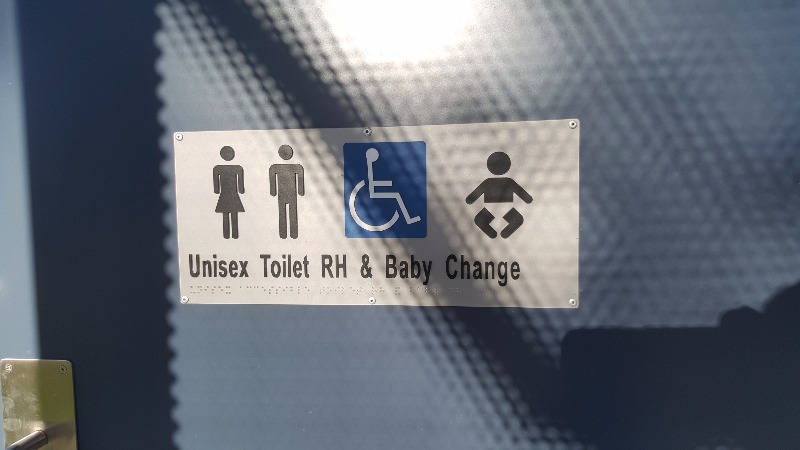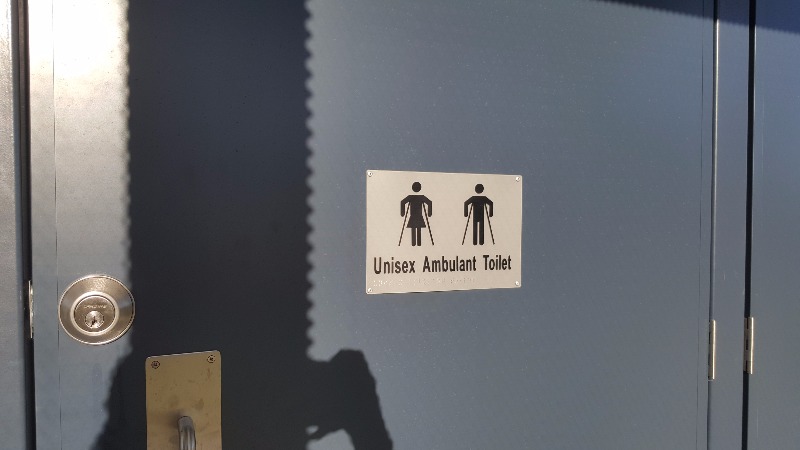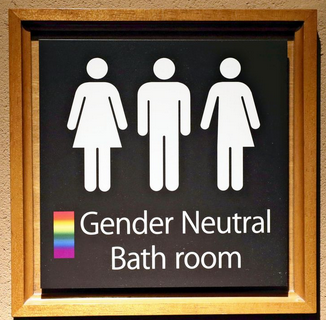- Forum
- categories
- Equity, inclusion and sanitation workers
- Gender issues
- Making public toilets more inclusive … are different toilet designs the answer? Unisex, all-gender, gender-neutral?
Making public toilets more inclusive … are different toilet designs the answer? Unisex, all-gender, gender-neutral?
34.9k views
- Elisabeth
-
- User is blocked
- Freelance consultant since 2012
Less- Posts: 3372
- Karma: 54
- Likes received: 932
Re: Are public toilets inclusive of transgender and intersex people?
Thanks for all the interesting information you had posted here. I still have it on my to-do list to incorporate this more fully into the Wikipedia article on unisex toilets but haven't gotten around to it yet (and was hoping to find someone who is more into this topic than I am who could help me with the editing). Currently it looks like this: en.wikipedia.org/wiki/Unisex_public_toilet
Meanwhile I thought I'd quickly share what toilet signs are common for public toilets in Australia (the land of the best public toilets in the world; OK maybe Singapore is even better, I don't know). They don't use the "half skirt" image but simply the male and female symbol and the text "unisex" underneath:
(I didn't know what RH and ambulant stands for. I found out: RH is for right hand and tells wheelchair users from which side they would have to lift themselves onto the toilet seat. Ambulant means: with disability but able to walk. These toilets have grab bars but don't have the extra space that a wheelchair users might require)
Elisabeth
Freelance consultant on environmental and climate projects
Attachments:
-
 20180617_1...8-13.jpg
(Filesize: 87KB)
20180617_1...8-13.jpg
(Filesize: 87KB)
-
 20180617_1...8-13.jpg
(Filesize: 73KB)
20180617_1...8-13.jpg
(Filesize: 73KB)
Please Log in to join the conversation.
You need to login to replyRe: Are public toilets inclusive of transgender and intersex people?
Starting with the section "Design" the Wikipedia article "Unisex public toilet" looks good.
The section on Portland seems accurate. The ordinance was passed in December 2015 and conversion of 600 city-owned direct-entry single toilet stalls in city parks started immediately. This interview with Anna Preble has photos of the October 2016 ribbon cutting when all were done. You might also look at this: Design Trends: Inclusion, Privacy, Efficiency, & Convenience . The All-User toilets toilets at the Stockholm Airport above the train station fit a tiny space but serve lots of travelers quickly and efficiently. By the way, I took all the photos in those blog posts and can release them to WikiMedia Commons (except the one of my family!)
As for the lead of the Unisex public toilet article, I'm less happy with it. I'm not sure unisex design has anything to do with sex or gender. That's the essence of the term "non-gendered", isn't it? Can't all of the discussion in the lead be moved to the bottom and discussed more fully in "Bathroom bills" or some other article?
A couple of handouts from the PHLUSH Public Toilet Advocacy Handbook might be useful in in finding more neutral language to describe why unisex stalls are desirable in most situations. I'm attaching the PHLUSH Design Principles for Public Restrooms and Direct Access Family and All-Gender Toilet Rooms
By the way, I'm not sure that "non-gendered" is not a term embraced by the LGBT community. I think in deference to them (and to rapid societal change) we should pay attention to their chosen terminology. These lists of LGBT Terminology may be helpful. www.hrc.org/resources/glossary-of-terms and lgbtrc.usc.edu/education/terminology/ and www.wearefamilycharleston.org/lgbt-a-z-glossary/
Thank you for your work on this: Elisabeth, Connie, Diane and others. I wish I had more time to join you. I do appreciate your questions.
Carol
Public Hygiene Lets Us Stay Human (PHLUSH)
1240 W. Sims Way #59, Port Townsend, Washington 98368 USA
Toilet availability is a human right and well-designed sanitation systems restore health to our cities, our waters and our soils.
This message has attachments files.
Please log in or register to see it.
Please Log in to join the conversation.
You need to login to reply- Elisabeth
-
- User is blocked
- Freelance consultant since 2012
Less- Posts: 3372
- Karma: 54
- Likes received: 932
Re: Are public toilets inclusive of transgender and intersex people?
I am now trying to convert what you said into "Wikipedia langage" and include it in the article or change existing wording. Not easy...
Conny, about this part:
As it currently stands I don't think this is the case in the Wikipedia article, e.g. right at the beginning of the Wikipedia article: 'Unisex public toilets can be used by people of any gender or gender identity, i.e. male, female, transgender, intersex.', however, 'male', 'female' and 'intersex' are sexes not gender identities. In particular intersex individuals may identify as women, or as men, and so be unhappy with 'intersex' being referred to as a gender.
--> Could you please propose better wording? I get confused with gender and gender identity, so need your help.
How should this sentence rather read?:
"Unisex public toilets can be used by people of any gender or gender identity, i.e. male, female, transgender, intersex. Gender-neutral toilet facilities can benefit transgender populations and people outside of the gender binary."
You also said:
For example 'sex-segregated' has been used to refer to public toilets with male only cubicles, female only cubicles and third gender only cubicles. Whereas in the Wikipedia article 'sex-segregated' is used to refer only to those with male only and female only options.
Where and how should we change the Wikipedia article accordingly?
And Carol, I have now included the Oregon example like this:
The City Council of Portland, Oregon passed an ordinance for "all user restrooms" in 2015. This ordinance directed all city bureaus to convert all "single-user gender-specific restrooms" into "all-user restrooms" within six months.[60]
Is that good? However, I was confused about the "6 month part" as the ordinance said:
Direct all City bureaus to convert existing single-user gender-specific restrooms into all-user
restrooms within 6 months of passage of this Resolution, to develop a plan to increase the
number of all-user restrooms Citywide, and to implement gender: neutral policies. (Resolution)
Does the "within 6 months" refer to the conversion or to the development of a plan? What is meant with "city bureaus"?
And since that ordinance was passed in 2015 do we have a more recent document that we can cite which details what has happened since then?
Overall, the Wikipedia article still needs a more balanced approach as it has too much focus on the U.S. at present and says too little about developing countries. I am actually thinking of moving some of the information about sex-segretated public toilets in the U.S. to another Wikipedia article called "bathroom bills" (en.wikipedia.org/wiki/Bathroom_bill) and focus this one more about the design aspects of unisex (or "all user") toilets, like Carol had mentioned.
If we want to add content about design aspects we need good reliable references that we can cite.
Regards,
Elisabeth
Freelance consultant on environmental and climate projects
Please Log in to join the conversation.
You need to login to replyRe: Are public toilets inclusive of transgender and intersex people?
Partner, Kellogg Consultants
Hope for Africa: Director Sanitation Projects
Project 16,000: Reusable Menstrual Products (pads and cups) for Ghana
Please Log in to join the conversation.
You need to login to replyRe: Are public toilets inclusive of transgender and intersex people?
There's been an unexpected development regarding the public toilet signage used to make LGBT people comfortable in Japan. Japan News reports that a number of city governments are removing their Gender Neutral Toilet signs because LGBT people don't like them.
Here are typical responses:
Entering restrooms with the marks is no different from coming out.
I want to use restrooms that match my gender identity.
The new data came from a joint study panel formed in August 2017 by LIXIL in collaboration with a diversity NGO. LIXIL's goal was "to propose what public restrooms should be like so that everybody can easily use them.” The panel interviewed 600 people, mostly company employees and university students.
Both LIXIL and the city governments assumed that the welcoming signs with rainbow marks were what gender non-binary folks wanted. Said one Osaka official following analysis of the results of the study, "“This was outside the scope of our assumptions. What’s important is that they can use restrooms without concern, and we decided that we don’t need to stick to just using the marks.”
Here's the article: the-japan-news.com/news/article/0004454617"City govts remove rainbow marks from public bathrooms / LGBT users cite concern over privacy"
Given cultural differences on toilet signage from country to country, maybe the gender discussion is not the most important thing. Whatever the label on the sign, “gender neutral" stalls are simply good public toilet design. Why? They offer the necessary privacy for individual users and also promote efficiency of user flow. Floor to ceiling walls create privacy. When one user leaves, the next enters. If one toilet fixture requires maintenance, there's no need to close off the whole facility. Very small stalls can be coupled with one or two larger family stalls. Putting sinks in a common public area instead of next to the toilet, also increases efficiency of user flow and may encourage handwashing as well.
Let's focus on making the physical layout of facilities we design work to make everybody safe and comfortable. Social and cultural differences across the globe are perhaps secondary. As you point out, Connie, agreement on terminology is not easy. Restroom preferences are not going to fit into any one linguistic package that works globally. I think Portland, Oregon got it right: ALL USER RESTROOM. Here is the Ordinance which passed City Council unanimously, was smoothly implemented and makes everyone happy. www.portlandoregon.gov/fish/article/572218
Carol
Public Hygiene Lets Us Stay Human (PHLUSH)
1240 W. Sims Way #59, Port Townsend, Washington 98368 USA
Toilet availability is a human right and well-designed sanitation systems restore health to our cities, our waters and our soils.
Attachments:
-
 ScreenShot...26AM.png
(Filesize: 201KB)
ScreenShot...26AM.png
(Filesize: 201KB)
Please Log in to join the conversation.
You need to login to reply- conniebenjamin
-
 Less
Less- Posts: 41
- Karma: 2
- Likes received: 20
Re: Are public toilets inclusive of transgender and intersex people?
I'd like to highlight a recent paper Transgender-inclusive sanitation: insights from South Asia
The paper highlights initiatives from across South Asia to make sanitation inclusive for transgender people as well as some recommendations for how to do so for practitioners. The case studies show the diversity of transgender identities and the solutions that suit their diverse needs and aspirations. The paper was written collaboratively with authors from many different organisations including transgender activists and academics.
I think this paper is particularly relevant to the Wikipedia article in several respects:
- Gender terminology: The paper is an excellent example of how to use terminology around gender and sex sensitively and accurately for the specific contexts discussed and also more generally. As it currently stands I don't think this is the case in the Wikipedia article, e.g. right at the beginning of the Wikipedia article: 'Unisex public toilets can be used by people of any gender or gender identity, i.e. male, female, transgender, intersex.', however, 'male', 'female' and 'intersex' are sexes not gender identities. In particular intersex individuals may identify as women, or as men, and so be unhappy with 'intersex' being referred to as a gender.
- Diversity of options available: The paper details a number of solutions preferred and used by transgender people and clearly distinguishes between them. It may be good to directly reference some of these in the article. I think it will also help distinguish options currently a little conflated in the Wikipedia article. For example 'sex-segregated' has been used to refer to public toilets with male only cubicles, female only cubicles and third gender only cubicles. Whereas in the Wikipedia article 'sex-segregated' is used to refer only to those with male only and female only options.
WaterAid
This email address is being protected from spambots. You need JavaScript enabled to view it.
Please Log in to join the conversation.
You need to login to replyRe: Are public toilets inclusive of transgender and intersex people?
The Sanitation Wikipedia team has worked on the article and made some improvements recently, but we could use quite a bit more input, and we need a few experts to give us an overall review of the quality. (none of us are experts)
Unisex Public Toilets en.wikipedia.org/wiki/Unisex_public_toilet
In addition to the need for an overall review, we have 4 specific requests.
1. Can you offer text to provide a more global perspective? Currently, there is far too much focus on the US debate on transgender issues.
2. Please offer text or information about unisex toilets in other countries, particularly in Muslim countries, that could provide a better balance,
3. Do you have good sketches (or photographs) of public toilets with signage that would be relevant to unisex toilets? Please post them.
4. Know of any research comparing unisex public toilets with gender-specific public toilets? Does it impact cueing time? comfort of girls and boys of school age? likelihood that people will wash their hands?
Also of value would be to have a few SuSanA members --no public toilet expertise needed--to give us their take on how valuable the article is as an educational tool. Is it comprehensive enough? Balanced enough? Is "unisex" even the right term to use?
Please use "reply" to give us your input, whether as an expert or as a generalist. Over 200 people read Wikipedia's "Unisex Public Toilet" every day: 43,000 in a year. "Getting it right" matters.
With appreciation,
Diane Kellogg
Sanitation Wikipedia team
Partner, Kellogg Consultants
Hope for Africa: Director Sanitation Projects
Project 16,000: Reusable Menstrual Products (pads and cups) for Ghana
Please Log in to join the conversation.
You need to login to replyRe: Toilets for Transgender Students – The Psychological Aspect
Connie Benjamin, WaterAid’s Policy Team Volunteer on Sanitation and Gender, and Andrés Hueso, Senior Policy Analyst for Sanitation, have pointed out the psychological stress among transgender students, if their gender-related toilets are not available:
(washmatters.wateraid.org/blog/the-rights...-to-go-to-the-toilet)
The blog is a useful input on the impact of non-availability of transgender toilets in educational institutions. It says:
“The simple act of going to the toilet at school or university can be a traumatic experience for transgender students. When the institution prevents a student from using the toilet that matches their gender identity, the student’s gender identity itself is undermined. The psychological impact of this shouldn’t be underestimated. There are reports of transgender students being verbally and physically harassed by other students when using the toilets. Forcing students who may be questioning their identity or are non-binary (identify neither as male or female) to choose between two options that don’t represent them may lead to a sense of discomfort or dysphoria.”
“In response to these challenges students may avoid going to the toilet altogether, which may cause dehydration, inability to concentrate and urinary tract infections. In short, when schools do nothing to help transgender students access toilets they may be putting these students at physical risk and under psychological stress. Access to toilets and sanitation is a human right for everyone, and protecting these vulnerable students should be a concern for all of us.”
The aspect of urinary tract infections for avoiding use of toilets is important. This is akin to the rural women in Pakistan and India, who have to wait till dark to use the bushes.
As referenced in the blog, the Trump administration has withdrawn a piece of federal guidance requiring transgender students to have unfettered access to bathrooms and locker rooms matching their gender identity, in a move that could embolden many schools to restrict trans rights.
F H Mughal
Karachi, Pakistan
Please Log in to join the conversation.
You need to login to reply- conniebenjamin
-
 Less
Less- Posts: 41
- Karma: 2
- Likes received: 20
I don't know of any information on the topic of sex-segregated/gender-neutral toilets from Pakistan specifically. Research on this topic at WaterAid is in very early stages.
Best,
Connie
WaterAid
This email address is being protected from spambots. You need JavaScript enabled to view it.
Please Log in to join the conversation.
You need to login to replyThank you for your very informative post. You rightly say:
".....This option is not recommended, however, in contexts and places where it may increase the risk of violence against women or transgender people, or where it is deemed culturally inappropriate."
While WaterAid is active in Pakistan, do you have information/experience of toilets (sex-segregated, transgender people) in Pakistan?
Regards
F H Mughal
Karachi, Pakistan
Please Log in to join the conversation.
You need to login to reply- conniebenjamin
-
 Less
Less- Posts: 41
- Karma: 2
- Likes received: 20
WaterAid conducted a literature review, which looked at what currently exists in the literature on the connection between LGBTI issues and sanitation. The paper was presented at the WEDC conference 2017, here is a link to the full paper: wedc-knowledge.lboro.ac.uk/resources/con...40/Benjamin-2649.pdf
Our research showed that the issue of transgender access to public toilets is under-addressed in the WASH sector. We also found evidence of transgender individual's facing abuse and harassment when attempting to access both male and female public toilets, amongst other challenges.
'...the challenges that transgender and intersex people face to accessing public toilets should be seen as a violation of several human rights, including the right to sanitation, the right to privacy and the right not to be discriminated against.'
from a blog post on the same topic: washmatters.wateraid.org/blog/sanitation...ng-beyond-the-binary
At WaterAid UK we have introduced gender-neutral toilets washmatters.wateraid.org/blog/toilets-fo...in-our-london-office
Gender-neutral toilets require adequate facilities for menstrual hygiene management, in whatever form is culturally appropriate, in every cubicle.
But the gender-neutral option is not to be recommend in all contexts:
'...gaining popularity in Western countries is gender-neutral toilets, where people can access all toilets irrespective of their gender. This option is not recommended, however, in contexts and places where it may increase the risk of violence against women or transgender people, or where it is deemed culturally inappropriate.'
I would add that gender-neutral toilets and sex-segregated toilets are not the only options, some countries and contexts have been exploring 'third-gender' toilets, this is even happening in schools
'A secondary school in Thailand introduced ‘third gender toilets’, solely for the use of their transgender students, who were facing difficulties including physical and verbal harassment when using the male and female toilets. This measure has reportedly been popular with the transgender students.'
washmatters.wateraid.org/blog/the-rights...-to-go-to-the-toilet
We have found this to be very much a live and pressing issue! It is something we are continuing to learn about and hope to encourage others to do the same.
WaterAid
This email address is being protected from spambots. You need JavaScript enabled to view it.
Please Log in to join the conversation.
You need to login to replyBut overall, this is a bit of a non-topic as toilet cubicles are inherently gender-neutral and you can just add some male-only urinals in a separate place, to make the cueing time for everyone (regardless of gender) a bit shorter.
Please Log in to join the conversation.
You need to login to reply- Forum
- categories
- Equity, inclusion and sanitation workers
- Gender issues
- Making public toilets more inclusive … are different toilet designs the answer? Unisex, all-gender, gender-neutral?








